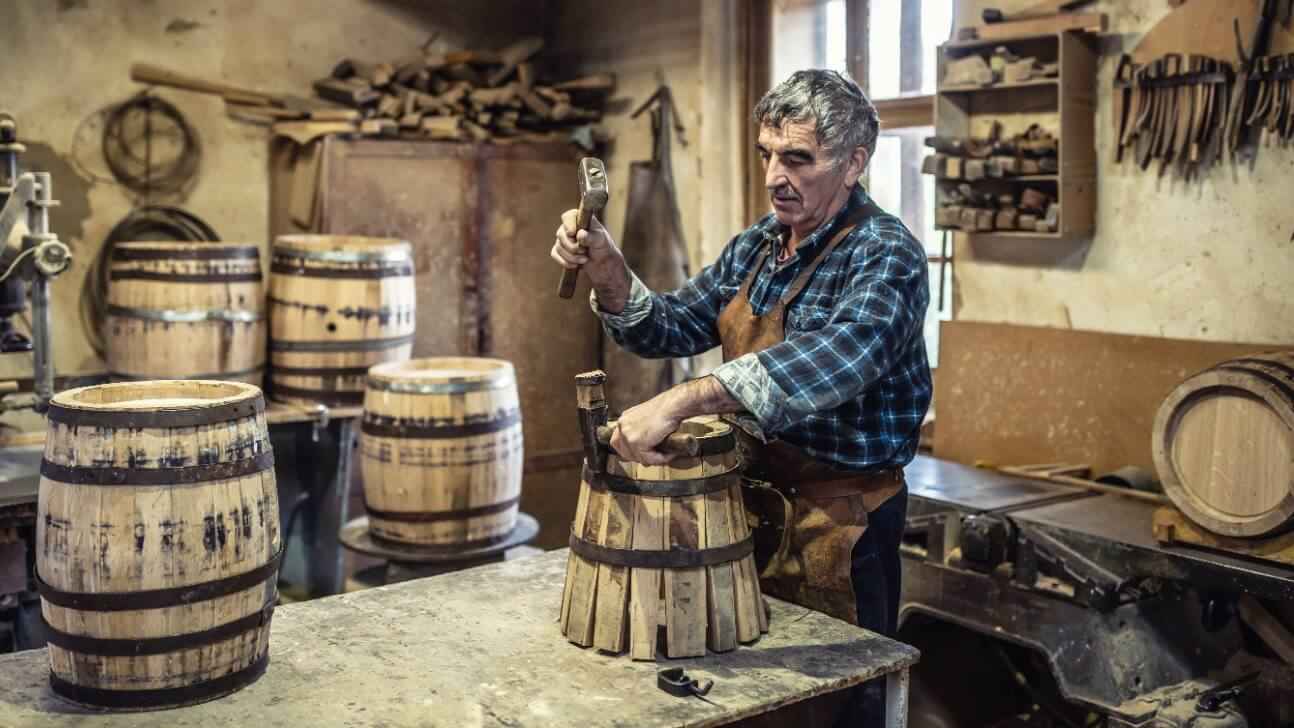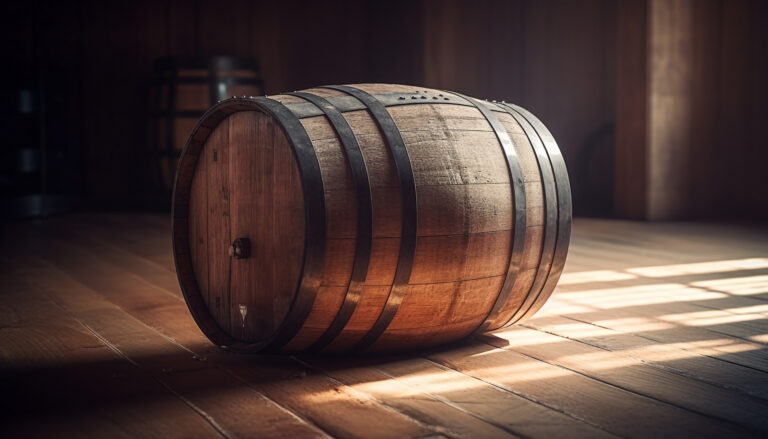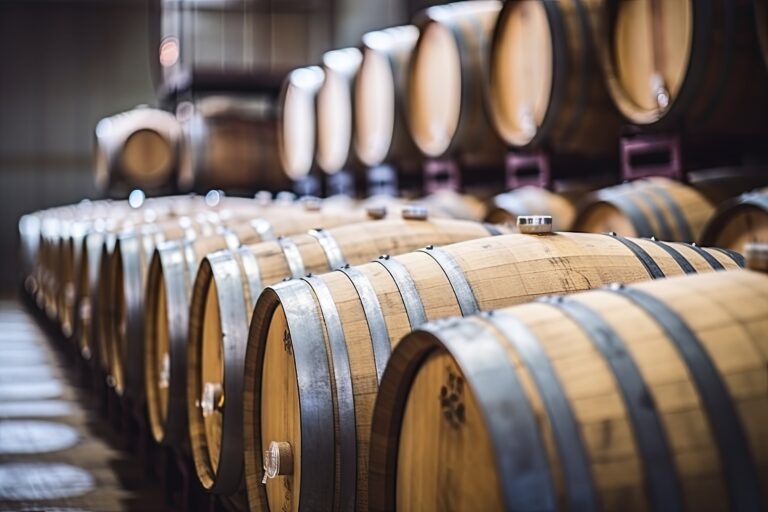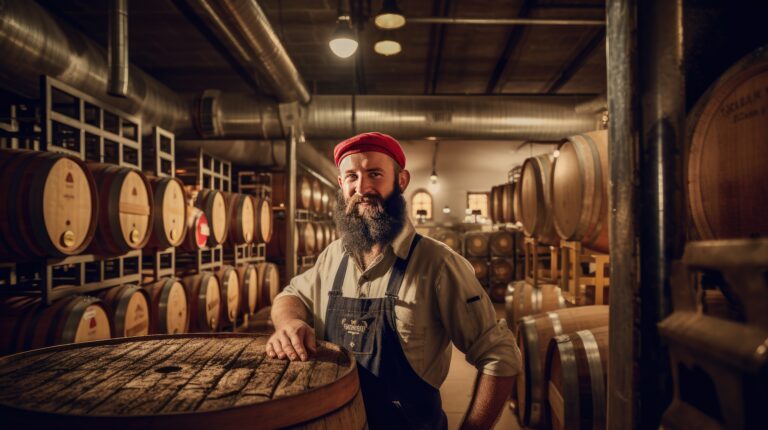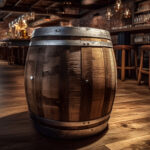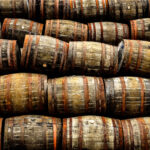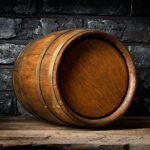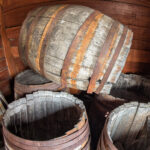You love your whiskey. Neat, on the rocks, in a cocktail—how it’s served doesn’t really matter as long as you get to enjoy the rich, smoky flavors and aromas that only aged whiskey can provide. But have you ever wondered how whiskey gets that distinctive golden color and smooth, oaky taste? It all comes down to the barrel. Whiskey barrels aren’t just any old containers, they’re specially crafted casks that impart flavor and color to the distilled spirit inside. The art of making these barrels is known as cooperage, an ancient craft that combines woodworking skills, manual labor, and a whole lot of patience. Follow along as we explore the step-by-step process of how whiskey barrels are made. You’ll gain a whole new appreciation for your next dram and the coopers who help create it.
Selecting the Right Wood for Whiskey Barrels
The type of wood used for whiskey barrels is critical. Oak has always been the favorite, as it imparts the most flavor to the spirit. Two varieties dominate: American white oak and European oak.
American white oak is porous, allowing more interaction between the whiskey and wood. Its vanilla and coconut notes shine through. Bourbon makers traditionally use white oak barrels.
European oak has tighter grain, producing more subtle flavors like dried fruit and spice. Scotch whisky producers often use European oak casks.
Once the wood is selected, the cooper shapes the staves into barrels. The staves are heated, bent, and bound with metal hoops. The heat and bending release compounds in the wood, priming the barrel to influence the whiskey’s flavor.
The barrel’s char and toast level also affect flavor. A light toast subtly influences the spirit. A heavier char produces smoky notes. The length of barrel aging further enhances the whiskey’s character based on the wood variety and char level.
Whiskey and wood have a symbiotic relationship. As whiskey ages, it soaks into the wood, extracting flavor compounds and color. In turn, the wood’s complexity develops over years of use, with each subsequent batch of spirit picking up traces of those aged in the barrel before.
Crafting a whiskey barrel requires skill, experience and an artistic touch. An artisanal cooperage can produce barrels tailored to a distiller’s specific needs and tastes. The wood, char, and aging are all carefully calibrated to create a whiskey with a distinct character. Barrel-making is an craft, and the cooper is instrumental in giving whiskey its flavor and golden hue.
Shaping the Staves With Steam and Fire
Once the staves have been shaped into curved planks, the cooper’s work truly begins. The staves must be bent and bound into a watertight barrel.
Shaping the Staves With Steam and Fire
To bend the staves, the cooper uses heat and moisture. The staves are stacked in a steaming chamber, where hot steam makes the wood pliable enough to bend. After steaming, the staves have to be quickly bent and secured before they cool and harden again.
The cooper places the bottom staves in a circular form and secures them with temporary metal rings. Then, more staves are added one by one, each stave getting narrower and more curved than the last. The cooper hammers metal rings over the staves to hold them in place as the barrel takes shape.
With the barrel fully assembled, the cooper seals and shaves the staves to make the surfaces smooth and watertight. The barrel is then charred on the inside by rolling it over a fire. The char creates a barrier between the wood and the whiskey.
Finally, the barrel heads are fitted and secured in place with more metal rings. Hoops of bent willow branches or metal strapping are wrapped around the outside of the barrel to apply strong but flexible pressure, further sealing and shaping the staves.
Once assembled, the new charred oak barrel must be seasoned before it can be filled. The barrel is left out in the open air for several weeks so the wood can absorb moisture from the atmosphere. The wood swells, sealing any small gaps. After it’s seasoned, the barrel is ready to be filled with new spirit and left to age into fine whiskey. Barrel making is an art form that whiskey lovers around the world can appreciate.
Assembling the Barrel One Stave at a Time
Assembling the barrel staves into a watertight container is an art form that takes years of practice to master. Cooperages that produce whiskey barrels follow a time-honored process that results in a perfect marriage of wood and whiskey.
Selecting the Staves
Coopers hand-select white oak staves that have been cured for at least 2 years. The staves must have a straight grain and be free of defects. Each stave is planed to ensure uniform thickness and a snug fit.
Raising the Barrel
The staves are assembled into a barrel shape using temporary metal hoops. The coopers gently heat the wood to make it pliable, then bend each stave at the precise angle needed. Once all staves are in place, the hoops are hammered down to hold everything together as the wood cools.
Toasting the Barrel
Before the barrel can be used, its interior must be toasted to impart flavor to the whiskey. A small fire is lit inside the barrel, which is rotated to ensure even heating. The level of toasting, from light to heavy, depends on the desired flavor profile. The barrel is then cooled and rinsed to remove any charred bits before filling.
Adding the Permanent Hoops
The temporary hoops are removed and replaced with permanent galvanized steel or wooden hoops that are precisely fitted to the barrel shape. The hoops are secured in place with small wedges driven into the gaps between staves. Any remaining gaps in the wood are sealed with a paste made of flour and water.
Sealing the Barrel
The barrel opening is fitted with a lid and sealed with a waterproof wax seal. Bung holes are drilled to allow filling and sampling of the whiskey. Once sealed, the barrel is ready to receive its precious cargo of new distillate, where it will age for at least 2 years and often much longer before bottling.
The cooper’s skill and artistry are instrumental to producing a barrel that can stand the test of time while mellowing and maturing the whiskey within. Their craft has endured for centuries, producing barrels that create some of the finest whiskeys in the world.
Toasting the Interior for Flavor Extraction
Toasting the interior of whiskey barrels is crucial for extracting flavors from the wood and imparting them into the spirit. Once assembled, barrels are toasted using a gas burner that gently chars the inside.
Coopering the Barrel
Coopers carefully toast each barrel to precise specifications provided by the distillery. The level of toasting depends on the type of whiskey that will be aged in the barrel and the flavor profile desired. More heavily toasted barrels produce bourbons and whiskies with darker, smokier flavors, while lighter toasting results in lighter, sweeter notes.
- The cooper slowly rotates and heats the interior using a gas burner, carefully charring the wood.
- The barrel is rotated to ensure even toasting.
- Once the desired toast level is reached, the barrel is cooled.
- The cooper then adds water to further cool and condition the barrel. The water is later drained.
Extracting Flavor Compounds
The heat from toasting breaks down the wood, releasing flavor and aroma compounds like vanillin and lactones trapped within. The water-soluble compounds infuse into the whiskey during aging, imparting distinctive notes of vanilla, caramel and smoke.
- The heat causes chemical reactions in the wood that produce these flavorful byproducts.
- The longer a barrel is toasted, the more compounds are created and extracted.
- When filled with whiskey, these compounds dissolve into the spirit.
- Over years of aging, the concentrations of these compounds increase, creating a complex, multi-layered flavor profile.
Toasting is truly an art form and demonstrates the cooper’s skill. The level of toast is carefully calibrated to produce barrels that will age whiskey with a distinct, well-balanced character. It’s one of the first steps in a long, flavorful journey.
Testing the Barrel’s Seal With Water
Once the barrel staves have been shaped and fitted together, it’s time to test if the barrel is watertight. This crucial step ensures that the barrel can properly age whiskey without leaking.
Filling the Barrel With Water
The cooper will fill the empty barrel with water to check for any leaks. As the water fills the barrel, the wood will swell, sealing small gaps. The barrel is left overnight so the water has time to soak into the wood.
The next day, the cooper will check the barrel for leaks by looking for water spots or drips on the outside of the barrel. If any are found, the problem area is marked. The water is then drained from the barrel.
Tightening the Barrel
Any leaks need to be sealed before the barrel can be used. The cooper will tighten the metal hoops that hold the staves together, or replace them with new hoops. The areas where leaks were found are then sanded down and sealed. Sometimes wood patches or peg inserts need to be added for a proper seal.
The barrel is then refilled with water to re-check for leaks. This process is repeated until the barrel holds water without any drips or seepage. A watertight barrel is essential to proper whiskey maturation.
Final Inspection
Once deemed watertight, the barrel undergoes a final inspection. The cooper checks that the barrel is balanced, with even and symmetrical staves. The bunghole, where the barrel is filled and emptied, must be level and secure. The barrel exterior is sanded smooth, and the barrel receives a final rinse with water to remove any wood dust before being approved as a finished product.
At last, the whiskey barrel is ready to be filled, aged and turned into a premium product. The art of the cooper in crafting each barrel is instrumental in giving whiskey its distinctive aroma, taste, and color. Their skills and handiwork are an integral part of the whiskey making tradition.
Branding and Customizing Each Barrel
Once the barrels have been constructed, it’s time to customize and brand each one according to the distiller’s specifications. This step turns a plain oak barrel into a vessel for aging premium whiskey.
Charring the Barrel
The inside of each barrel is charred by burning, which helps impart flavor and color to the whiskey. The level of char depends on the distiller’s preference – light, medium or heavy. A heavier char means more of the wood is burned, resulting in smokier, darker whiskey. The char creates a layer of carbon in the wood that helps filter and mellow the spirit.
Adding the Bunghole and Spigot
A bunghole, also known as a barrel hole or stopper hole, is drilled into one end of the barrel. A spigot, or spile, is placed a few inches above the bottom of the barrel. These features allow the barrel to be filled, sampled and emptied.
Branding the Barrel
Distillers often brand barrels, stenciling or burning their logo and other information like barrel number, date of manufacture, type of wood and level of char onto the outside of the barrel. Branding helps identify the provenance and specifications of each barrel.
Testing the Barrel
Before filling the barrels with whiskey, distillers test each one to ensure there are no leaks. Barrels are filled with water and left to sit for several days. If the water level remains the same and there are no visible leaks, the barrel passes the test. Any leaky barrels cannot be used to age whiskey.
Preparing the Barrel for Filling
Finally, the bunghole and spigot are removed, the barrel is drained, rinsed and dried. It’s now ready to be filled with new distillate, where it will age and mature into premium whiskey over months and years. The art of cooperage is instrumental in creating the distinctive flavor, aroma and color of aged whiskey. These custom-made barrels give whiskey its characteristic oakiness and help each brand develop a unique identity.
Aging Whiskey in Charred Oak Barrels
Aging whiskey in charred oak barrels is what gives bourbon its distinctive flavor and color. The inside of the barrels are charred, meaning the wood is burned, before being filled with whiskey. This charring process releases compounds from the wood that impart delicious flavors to the whiskey as it ages.
The Aging Process
As whiskey ages in the charred barrels, it absorbs flavors and colors from the wood. The whiskey enters the barrel clear and flavorless, but after years of aging, it emerges a warm, amber color with notes of vanilla, spice and toasted nuts. The longer the whiskey ages, the more complex its flavor becomes. Many bourbons are aged 3-5 years, but some premium brands age their whiskey 10-20 years or more.
The Wood Factor
American white oak is the wood of choice for whiskey barrels. Its tight grain prevents leaks, while allowing the whiskey to breathe. Oak also contains compounds like lactones and phenols that provide flavor to the whiskey. The level of char on the inside of the barrel impacts flavor – the more heavily charred the barrel, the smokier the flavor imparted to the whiskey. Barrels may be used several times, with each use imparting more subtle flavors.
The Angel’s Share
As whiskey ages in the barrels, some of the liquid evaporates – this is known as the “angel’s share.” The angel’s share is usually around 2% per year of aging. While this may seem wasteful, it actually helps concentrate the remaining whiskey’s flavor and aroma compounds. The climate where barrels are aged also affects the angel’s share and how quickly the whiskey matures. Colder climates mean slower aging, while warmer areas speed up the aging process.
The art of cooperage and aging whiskey in charred oak barrels is a time-honored tradition that produces some of the finest tasting spirits. While modern technology could speed up the aging process, for many distillers and consumers alike, some things are worth the wait.
The Cooperage Tradition Through the Ages
The ancient art of cooperage, or barrel making, goes back thousands of years. For centuries, coopers have been crafting barrels to serve many purposes, from storing and transporting goods to aging wines and spirits.
The cooperage tradition remains an integral part of whiskey production today. Master coopers, or barrel makers, continue the time-honored craft of hand-making charred oak barrels, which are essential for maturing whiskey and giving it distinctive flavors and aromas.
Selecting the Wood
The coopers begin by selecting high-quality oak, typically American white oak or European oak. The oak is cut into staves, or long planks, that are seasoned for at least two years. Seasoning the wood removes moisture and tannins, preventing leaks in the finished barrel.
Shaping the Staves
The staves are shaped into curved pieces that will form the barrel. Grooves and bevels are cut to allow the staves to fit together snugly. Steel or wooden hoops are fitted around the outside of the staves to hold them in place.
Toasting and Charring
Before the barrel heads are attached, the inside of the barrel is toasted and charred over an open flame. The level of toasting and charring depends on the desired flavor profile. The charring caramelizes the wood sugars and releases aromatic compounds that will flavor the whiskey.
Finishing Touches
The barrel heads are secured and the exterior is branded with the cooperage’s symbol. Bungholes are drilled in the side of the barrel to allow filling and emptying. The water-tight barrels are now ready to be filled with distilled spirit.
The age-old craft of the barrel maker lives on in the whiskey industry. Thanks to the dedication of coopers around the world, we can continue to enjoy the fruits of their labors—deliciously complex and flavorful aged whiskeys. The cooper’s time-honored tradition enhances our appreciation of this noble spirit.
The Art of Cooperage FAQs: Your Barrel Making Questions Answered
Cooperage is an art form that has been practiced for centuries. Crafting whiskey barrels requires knowledge, skill, and patience. If you’ve ever wondered how those oak barrels are made, here are the answers to some frequently asked questions about the barrel making process.
What types of wood are used to make whiskey barrels?
Barrels used for aging whiskey are typically made of American white oak. Oak is ideal because it’s porous, allowing the whiskey to absorb flavors from the wood. Oak also has natural compounds like lactones and vanillins that impart flavor to the spirit.
How are the staves shaped and prepared?
The staves, or long wooden planks, are cut and shaped to form the barrel. They are heated and bent to the proper curve, then held in place with metal rings. The staves are charred on the inside to help filter and mellow the whiskey. Char levels can range from light to heavy depending on the desired effect.
How are the barrels constructed?
Skilled coopers hand assemble the barrels. They fit together the bent staves, securing them with metal hoops. The barrel is toasted to bend the staves and seal the wood. A water test ensures the barrel is watertight before filling. The barrels are readied for filling and aging the whiskey.
How long does it take to make a barrel?
Crafting a single whiskey barrel can take a cooper up to 8 hours of labor. Seasoned coopers work carefully and efficiently, though the process cannot be rushed. From cutting and shaping the staves to the final construction and toasting, cooperage remains a time-honored craft.
How many times can a barrel be used?
Whiskey barrels are often used more than once. After an initial aging period, the barrel is emptied of its contents. It can then be refilled and used to age another batch of whiskey. Most barrels are used 3 times before being retired. As barrels are re-used, they impart less oak and more complex flavors to the whiskey. Some distilleries prefer the flavors from first-use barrels, while others like the effects of multi-use barrels.
The ancient craft of barrel making is truly an art form. Skilled coopers and the highest quality oak staves come together to produce the whiskey barrels essential for aging and flavoring spirits. The next time you enjoy a glass of whiskey, appreciate the craftsmanship and tradition behind its oak barrel home.
Final Thoughts
So there you have it, an inside look at the centuries-old craft of cooperage and how those oak barrels are made that give your favorite bourbon its signature taste. The cooper’s art is truly a labor of love that combines natural materials, specialized skills, and a dedication to quality. Next time you pour yourself a glass of that aged whiskey, swirl it, breathe in the aromas of vanilla and caramel, and take a slow sip, think about the coopers who crafted the barrel it was aged in. Their passion and hard work created the vessel that turned mere distilled spirits into liquid gold. Appreciate the craftsmanship and artistry that went into making your drink an experience to savor. The cooper’s trade lives on, and for that all whiskey connoisseurs can raise their glasses in thanks.
